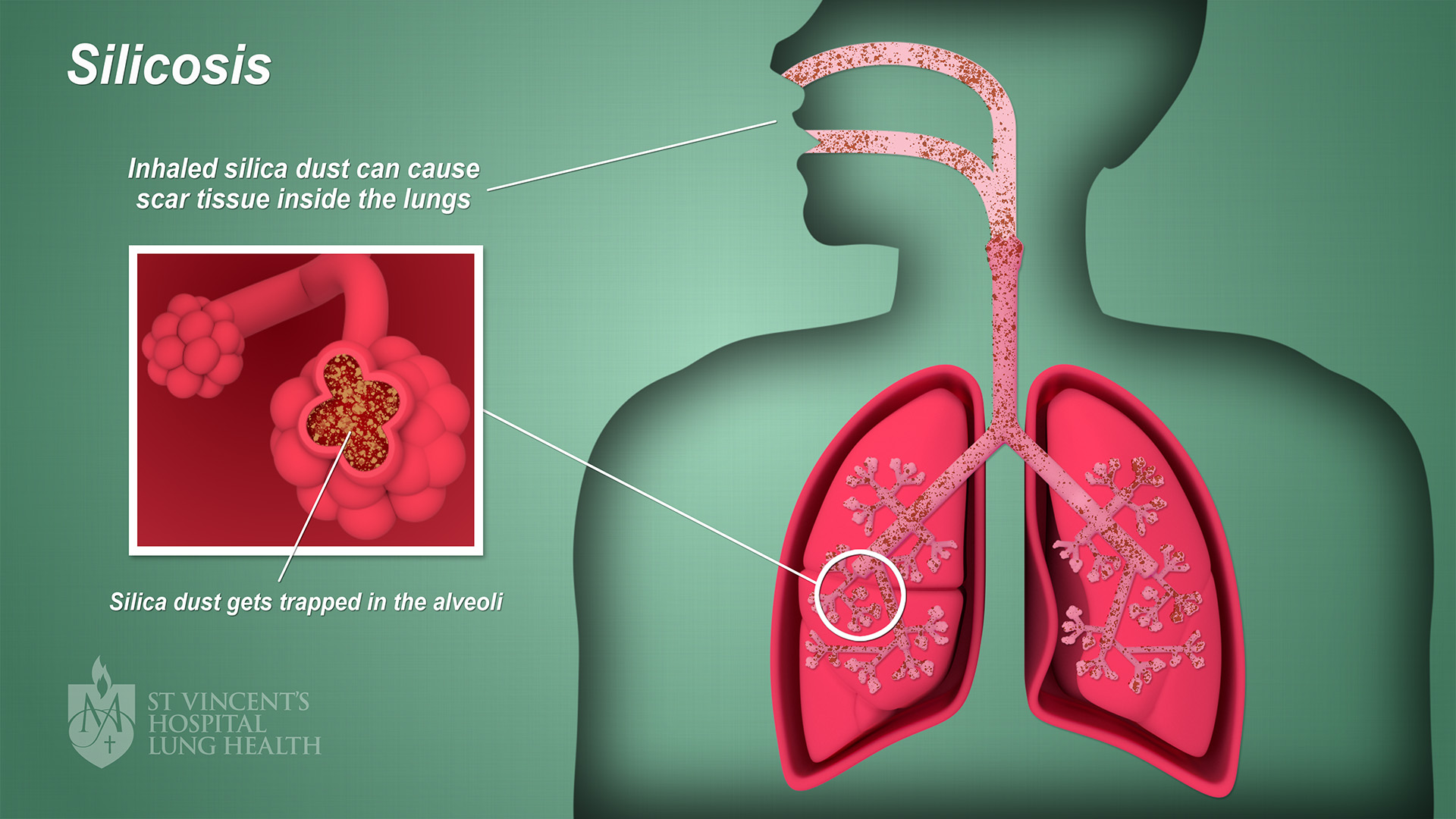Silicosis
What is silicosis?
What are the causes of silicosis?
What are the signs and symptoms of silicosis?
What are the possible tests to diagnose silicosis?
What are the possible treatments for silicosis?
What is the future plan if you have silicosis?
What is silicosis?
Silicosis is a lung disease caused by breathing in tiny particles of silica, called crystalline silica. Silica is a mineral found in sand, concrete, rocks and glass.
A versatile mineral, silica is used to make kitchen benches, bathrooms, bricks, tiles and some plastics. But, when silica is cut, drilled or ground, tiny particles enter the air. These particles are so small they can be inhaled. Once inhaled, silica particles get stuck in the lungs, causing scarring and fluid build-up, making it hard to breathe.
The image below illustrates silicosis.

What are the causes of silicosis?
Silicosis is caused by inhaling crystalline silica. People who are involved in making products containing silica are most at risk.
Jobs that can expose workers to crystalline silica include:
- Construction workers
- Engineers
- Farmers
- Miners.
Your exposure to silica dust is increased if you work in a job where you need to grind, crush, drill, break or mill material containing silica, such as:
- Angle grinding, jack hammering and chiselling of concrete or masonry
- Brick, concrete or stone cutting
- Clay and stone processing machine operations
- Constructing and installing composite stone countertops
- Demolition work
- Excavation, earth moving and drilling plant operations
- Foundry casting
- Glass manufacturing
- Hydraulic fracturing of gas and oil wells
- Mineral ore treating processes
- Paving and surfacing
- Pottery making
- Road construction
- Sand blasting
- Tunnelling.
Your body can get rid of some dust you breathe in. But if you work in a job where you are exposed to high levels of dust for a long time, or work with products containing a high amount of silica, then your lungs become overwhelmed. As a result, your lungs can’t get rid of all the dust.
What are the signs and symptoms of silicosis?
There are three types of silicosis, and each type affects the body differently.
|
Type
|
Occurs when
|
Symptoms
|
|
Acute silicosis
|
Within a few weeks or years of silica exposure
|
Cough
Weight loss
Tiredness
Sharp chest pain Breathlessness
|
|
Chronic silicosis
|
10 to 30 years after silica exposure
|
Inflamed lungs
Fluid build-up
Breathlessness
Low blood oxygen
|
|
Accelerated silicosis
|
Within 10 years of frequent silica exposure
|
Swelling in the lungs
Swelling in the chest lymph nodes
Difficulty breathing
|
What are the possible tests to diagnose silicosis?
If you have symptoms of silicosis, your doctor will take a range of tests to make a diagnosis. Common tests include:
- Biopsy of the lungs – to study a small sample of lung tissue
- Bronchoscopy – to look at the inside of the lungs
- Chest CT scan – to look for signs of silicosis
- Chest X-ray – to diagnose the type of silicosis and look for signs of scarring
- Exercise test – to see how your lungs respond to exercise
- Lung function tests – to check how well you are breathing
- Physical examination – to determine if you work in an at-risk industry.
What are the possible treatments for silicosis?
Silicosis can’t be cured, but there are treatments to help improve your symptoms and quality of life.
Possible treatments for silicosis include:
- Medications – some medications can relax your airways and reduce the amount of fluid in your lungs, and research will be undertaken soon to explore how medication may be able to slow the lung scarring in this disease
- Oxygen support or non-invasive ventilation (NIV) – a hospital treatment of extra oxygen helps you to breathe better and supports your lungs
- Surgery – people with severe cases of silicosis may need a lung transplant.
You can prevent silicosis from getting worse by limiting your exposure to silica. It’s important to have proper ventilation and use personal breathing equipment if you are exposed to silica.If you work in a high-risk job, speak to your employer about the correct protection and equipment.
What is the future plan if you have silicosis?
If you have silicosis, your doctor will give you a long-term treatment plan. The aim of treatment is to stop the disease from getting worse and manage your symptoms. You will need to:
- Get frequent health checks – as well as long-term monitoring
- Get your regular vaccinations – these help to prevent lung disease like cold and flu
- Have regular tests to check your lung function – to detect any symptoms of lung disease
- If you smoke, quit – smoking further damages your lungs, so phone 13QUIT to get started
- Learn about your disease – be informed, so you know how to prevent your disease from getting worse
- Limit your exposure to silicosis – you may need to consider changing jobs
- Maintain a healthy lifestyle – speak to your doctor about developing a healthy diet and exercise plan
- Stay away from known lung irritants – including air pollution and cigarette smoke.
If you have silicosis, you may be entitled to compensation. To learn more, visit https://www.safeworkaustralia.gov.au and speak with your employer.